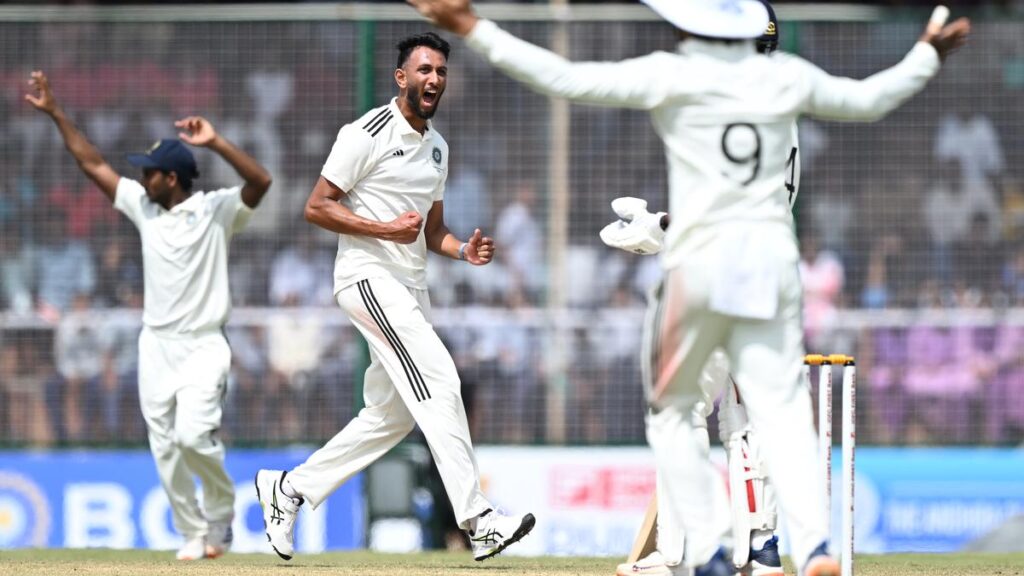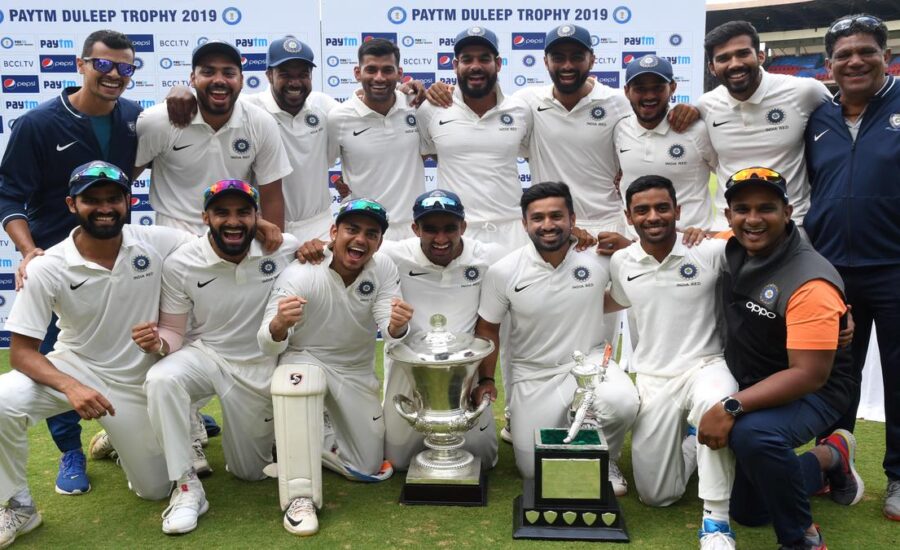The state units rejected the four-team format this season. Hence, the Duleep Trophy will resume its previous zonal format starting in 2019.
Four teams participated in the red-ball competition: India A, India B, India C, and India D. Earlier this month, India A defeated India C to win the contest.
The tournament typically includes six teams from each of the following zones: central, east, west, north, south, and northeast. This gives the players from each zone additional opportunities.
“The state units believed that the players from their respective zones needed to be more fairly represented by the format employed this season. After today’s BCCI AGM in Bengaluru, a state unit official informed PTI that players had better possibilities zone-wise under the conventional zonal model.
This season, the BCCI renamed the Duleep Trophy, and with several well-known Indian players participating in the opening round, the competition garnered considerable attention.
In this event, Rishabh Pant made his red-ball comeback with a self-satisfying half-century. After leading the India A team during the first round, Shubman Gill gave over the captaincy to Mayank Agarwal so he could join the India Test team for the current series against Bangladesh.
The Indian players competing in the competition were opener Yashasvi Jaiswal, Sarfaraz Khan, Akash Deep, Kuldeep Yadav, K L Rahul, and Dhruv Jurel.
In addition to helping Akash save his spot in the Indian squad, his outstanding performance in the first round provided an opportunity for the next generation of cricketers to make an impression ahead of a demanding Test season.
Additionally, left-arm bowler Yash Dayal was selected for the Tests following a strong performance in the Duleep Trophy.
Ruturaj Gaikwad, who has yet to play a Test match, captained India C, while Shreyas Iyer, who was benched for the Bangladesh series, led India D.
Like Iyer, Ishan Kishan lost his central contract for playing domestic cricket against the BCCI’s directive. Still, he made a spectacular comeback with a brilliant century.
The participation of fringe players and regulars from India gave the event new vitality.
The Duleep Trophy is the tournament that best represents the rich legacy of Indian cricket. A mainstay of Indian domestic cricket for many years, the Duleep Trophy is renowned for developing young talent and getting players ready for the big stage. The Board of Control for Cricket in India (BCCI) had to give up its plans for a new format. However, certain recent adjustments it had proposed caused a major controversy in the cricket world. This post will discuss the controversy surrounding the Duleep Trophy and the reasons the BCCI had to change its mind.

The Duleep Trophy: What is it?
Founded in 1961, the Duleep Trophy is an esteemed domestic cricket event in India’s first class. It was created to match the best cricket players in the region against one another in India, guaranteeing that players from various zones may compete at a high caliber prior to joining the national squad.
The Tournament’s Evolution and History
The competition, which bears the name of one of India’s early cricketing superstars, Duleepsinhji, has changed over time. At first, five regional zones competed in the competition: North, South, East, West, and Central. Different modifications were made over time to increase domestic cricket’s level of competition and quality.
Relevance in the Domestic Cricket Circuit of India
The Duleep Trophy has a unique place in Indian cricket. It gives athletes a chance to demonstrate their abilities on a bigger stage, which frequently determines whether they are picked for India’s national team. Numerous Indian cricket stars, such as Rahul Dravid and Sachin Tendulkar, have emerged from this competition.
Shaping the Future of Indian Cricket Players
The Duleep Trophy is a doorway to success for young cricketers. The zonal structure gives players the opportunity to compete against the top players in the nation, helping them hone their skills and develop resilience.
Proposed Modifications to the Duleep Trophy by BCCI
The BCCI announced its intention to redesign the Duleep Trophy in 2023. These modifications were intended to modernize and maintain the competition in line with Indian cricket’s changing requirements.
Information on the New Format
The new format’s most notable modification was its departure from the zonal competition paradigm. In an attempt to increase competition, the BCCI suggested creating teams based on performance data, which would classify players differently. A more performance-based model took the place of the Duleep Trophy’s central component, the zonal identity.
Justification for the Format Change
As per the BCCI, the concept was to provide a framework that fosters performance-based selections, enabling the top players from all around India to compete against one another. This action was viewed as a component of the bigger plan to properly prepare players for the demands of international cricket, where individual performance takes precedence over local allegiance.
Purposeful Advantages of the New Organisation
The board thought that this modification would give the Duleep Trophy more energy and better represent the needs of contemporary cricket. By classifying players according to their form and performance, they aimed to remove regional prejudice and promote more competitive play.
The Opposition to the New Format
Despite the BCCI’s stated goal of advancement, the suggested modifications received a resoundingly negative response. Fans and athletes alike expressed their displeasure loudly.
Issues Voiced by Coaches and Players
Cricket players voiced reservations over the new format, especially those who had profited from the zonal system. Many saw the zonal rivalry as a treasured custom that had aided in their rise to prominence. Coaches contended that the zonal system forced players to distinguish themselves from players from other regions and fostered the development of regional talent.
Reactions from Former Players and Experts in Cricket
A number of former cricket players, including Kapil Dev and Sunil Gavaskar, publicly criticized the decision. They felt that making changes to the established structure would lessen the significance of the Duleep Trophy. These specialists contended that there was little reason to abandon the zonal system because it had a successful track record.
Fan Responses on Social Media and Other Platforms
As soon as the modifications were announced, social media was flooded with responses. The loss of the zonal rivalry infuriated ardent cricket fans, especially those who had watched domestic cricket intently. Fans started to use hashtags like #SaveDuleepTrophy to express their desire for the BCCI to reconsider its choice.
Why did the BCCI abandon the New Format?
After intense criticism from many quarters, the BCCI ultimately decided to drop the new Duleep Trophy format.
Domestic Cricket Stakeholder Pressure
Pressure from several domestic cricket stakeholders played a significant role in the BCCI’s decision to reverse course. The planned modifications were met with opposition from players, coaches, and regional cricket bodies, who contended that the new structure would jeopardize the fundamental basis of domestic cricket in India.
Effect on the Development and Performance of Players
Concerns have also been expressed about the potential effects of the new format on player development. Since the zonal system had produced some of India’s best cricket players in the past, many people thought that the performance-based format would interfere with the routes that aspiring players took to reach the national team.
Respecting the Conventional Cricketing Values
In the end, the custom prevailed. The BCCI understood how critical it was to preserve the tournament’s unique identity and historical significance. The board recognized that some aspects of cricket are better left unaltered, which is why it returned to the previous format.
Prospects for the Duleep Trophy in the Future
The Duleep Trophy, a mainstay of Indian domestic cricket, is set to carry on its history with the cancellation of the new format. But this episode makes significant arguments regarding the tournament’s future and how to change it without losing its core.
Reforms That Might Be Effective
Reform is still possible even though the zonal system is here to stay for the time being. Experts in cricket have recommended that the BCCI look for innovative ways to add flair without undermining the tournament’s heritage.
Advice from Cricket Experts
Numerous commentators on cricket have suggested maintaining the zonal identity while making small adjustments, such as adjusting the points structure or increasing player incentives.
Finding a Balance Between Tradition and Progress
The BCCI’s ability to find a balance between updating the competition and maintaining its rich history will determine the Duleep Trophy’s future. In addition to keeping the competition current, this balance will guarantee that India continues to develop elite cricket players.
In summary
The cricketing community reacted strongly to the BCCI’s decision to scrap the new Duleep Trophy format. Even though the suggested modifications were meant to bring the tournament up to date, the consensus was that tradition should be maintained. The Duleep Trophy is still an important fixture in Indian domestic cricket, and its influence on the next generation of players cannot be understated.
